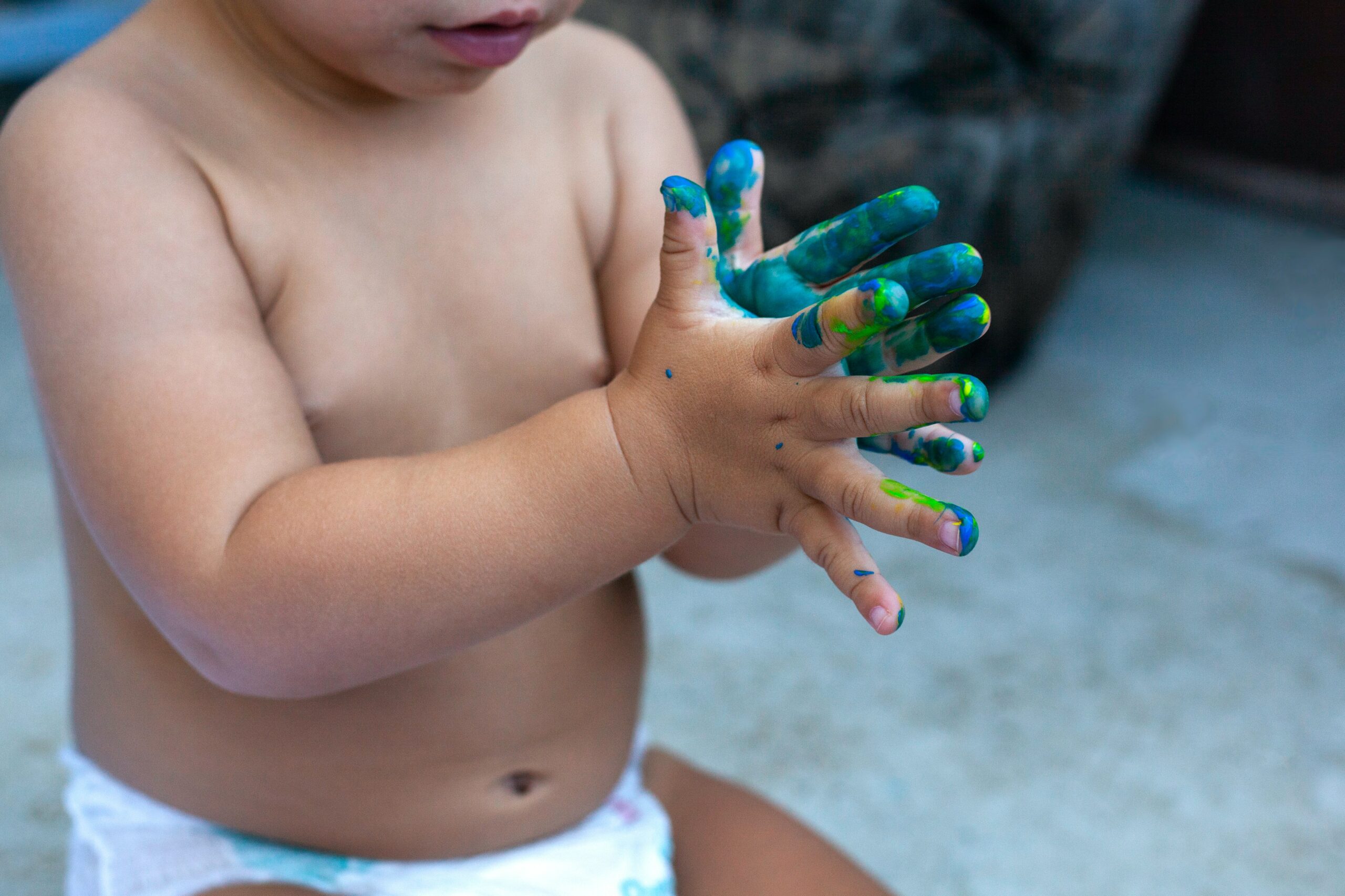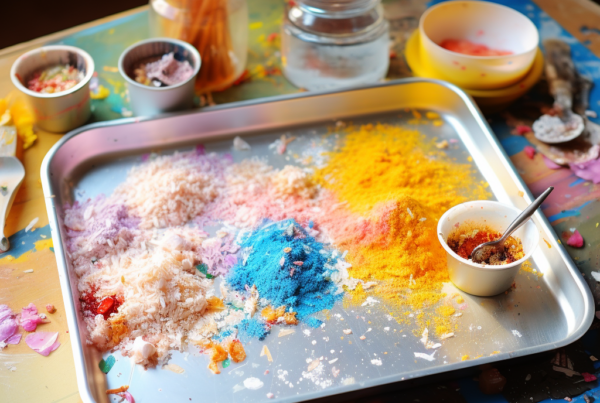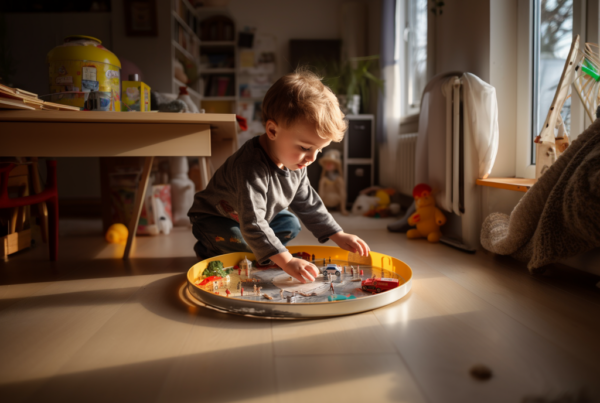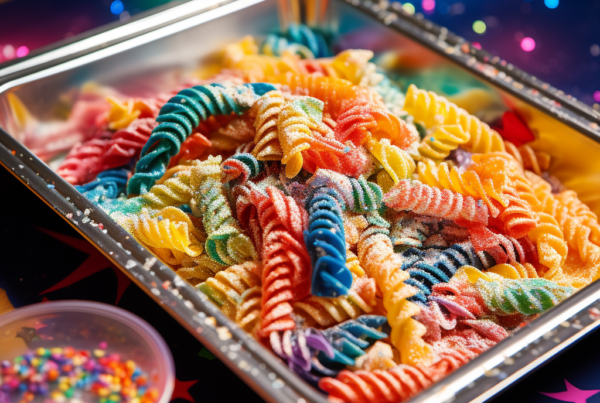If you’re a parent or caregiver of a toddler, you know how important it is to keep them engaged and learning. And that’s where our tuff tray ideas for toddlers come in! Tuff trays are a versatile and durable play surface that provides a contained space for sensory play. Sensory play is crucial for a child’s development, as it helps them to explore their environment, develop fine motor skills, and learn through their senses.
So, what exactly is a tuff tray?
It’s a shallow plastic tray, usually around 1 metre in diameter, that can be filled with a variety of materials such as sand, water, or play dough. Tuff trays can be used both indoors and outdoors, making them an excellent option for all kinds of weather. While the official tuff trays are great, I personally use The PlayTRAY from Inspire My Play – you can buy it from Amazon here.
But why are tuff trays such a fantastic tool for sensory play? First and foremost, they offer a safe and contained space for children to explore and experiment with different materials. They also encourage children to use their imagination, problem-solve, and develop creativity.
Children can learn about cause and effect by playing with tuff trays, expand their vocabulary, and learn to cooperate with others. Plus, tuff trays are just plain fun!
In the following sections, we’ll take a closer look at some of the top tuff tray ideas for sensory play and offer some tips for setting up a tuff tray.
Let’s get started!
Top Tuff Tray Ideas for Toddlers Sensory Play
Now that you know what a tuff tray is and why they are so beneficial for toddlers, let’s explore some of the top tuff tray ideas for sensory play. There are endless possibilities when it comes to tuff trays, but here are some of our favourite ideas to get you started:
Nature Tray with Leaves, Flowers, and Rocks
A nature tuff tray is a fantastic way to introduce your child to the natural world. Start by going on a nature walk with your child and collect items such as leaves, flowers, and rocks. When you get home, fill the tuff tray with the collected items. Encourage your child to explore the objects’ different textures, colours, and shapes. They can sort them by size, shape, or colour or create patterns with them. You can also use this tray to encourage your child’s creativity by inviting them to make a nature collage or a piece of art using natural materials.
Play Ideas:
Sorting: Encourage your child to sort the items into categories, such as big and small, round and square, or by colour.
Sensory exploration: Encourage your child to touch the different items in the tray. Ask them to describe what they feel, such as rough, smooth, or bumpy.
Creative play: Encourage your child to use the items to create a nature-themed artwork or collage. You can also encourage them to use their imagination to create a story or game with the items.
Water Tray with Boats and Water Toys
A water tuff tray is a classic choice for sensory play. Fill the tray with water and add boats, toys, measuring equipment and sponges for your child to explore. Children can experiment with the way objects float or sink, pour water from one container to another, or simply enjoy splashing and playing in the water. This type of tray is especially great for warm weather, as it provides a refreshing activity to cool down on a hot day.
Play Ideas:
Experiment with floating and sinking: Encourage your child to experiment with different objects in the water and observe how they behave. You can ask questions to spark their curiosity and nurture their prediction skills such as, “Which toy do you think will float, and which will sink?”
Pouring and scooping: Provide cups and containers for your child to practise pouring and scooping the water. You can also add food colouring or bath bubbles to make it more interesting.
Sensory exploration: Encourage your child to feel the water and explore the different temperatures and textures.
Sand Tray with Scoops and Moulds
A sand tuff tray is another popular choice for sensory play. Fill the tray with sand and provide scoops, moulds, and other tools for your child to play with. Children can create sandcastles, explore the properties of sand, and use their imaginations to build anything they can dream up. Sand is also great for developing fine motor skills, as children can practise pouring, scooping, and shaping with their hands and tools.
Play Ideas:
Building and creating: Encourage your child to use their imagination to create sandcastles, sculptures, or other structures. You can also provide tools such as spoons or forks to help them make interesting patterns and designs. Incorporate items such as silicone cupcake cases, ice-cream cones and sprinkles for foodie fun.
Sensory exploration: Encourage your child to explore the different textures and properties of the sand, such as wet vs dry sand or coarse vs fine sand.
Counting and measuring: Provide cups, spoons, scales and other tools for your child to practise measuring and weighing the sand.
Play Dough Tray with Cutters and Rollers
Playdough is a classic children’s toy, and a play dough tuff tray takes the fun to the next level. Fill the tray with play dough and provide cutters, rollers, and other tools for your child to use. Children can practise their fine motor skills by kneading and shaping the dough or using their imaginations to create shapes and designs. This type of tray is also great for encouraging social interaction, as children can play together and share their creations.
Play Ideas:
Creative play: Encourage your child to use their imagination to create anything they can dream up. They can make animals, people, or abstract shapes. You can also encourage them to create a story or game with their creations.
Fine motor skills: Provide tools to help your child develop their fine motor skills. They can practise cutting, rolling, squashing or stamping the dough.
Sensory exploration: Encourage your child to explore the different textures and properties of the dough, such as soft, squishy, or moldable. You could even make your own dough and add sensory items such as oats, sprinkles or glitter for added fun!
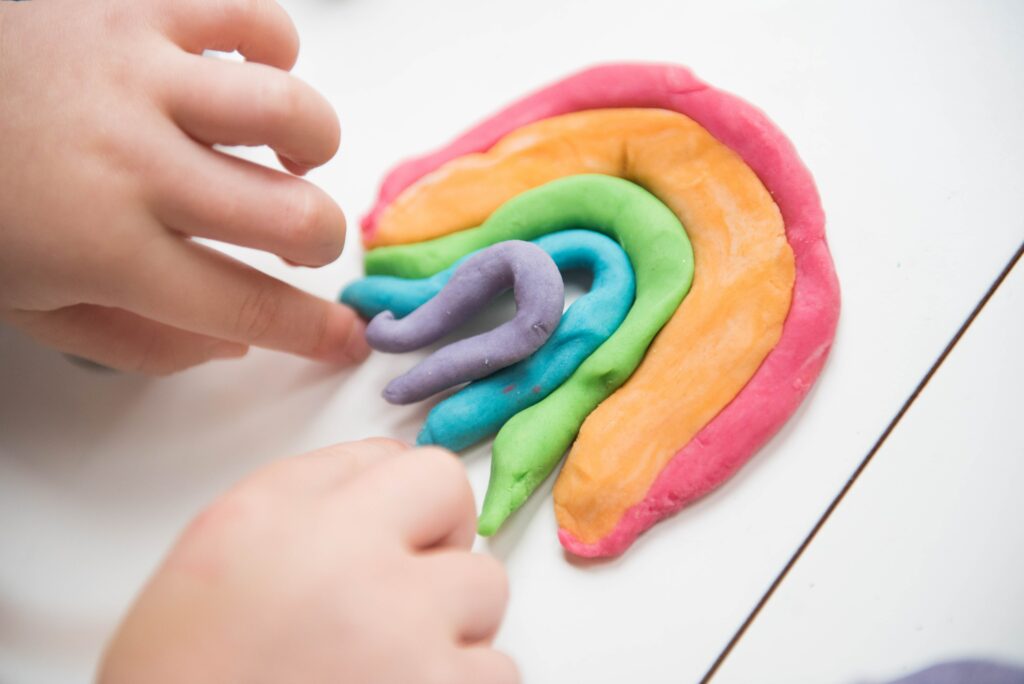
Construction Tray with Blocks and Trucks
If your child loves to build and create, a construction tuff tray is perfect. Fill the tray with blocks, trucks, and other construction toys, and let your child’s imagination run wild. Children can create towers, roads, and other structures or use the toys to act out imaginative scenarios. This type of tray is also great for encouraging problem-solving skills and spatial awareness.
Play Ideas:
Building and creating: Encourage your child to use their imagination to construct buildings, roads, or other structures. They can also use the toys to act out imaginative scenarios or stories.
Problem-solving: Encourage your child to experiment with different ways to build structures or use the toys to solve problems.
Spatial awareness: Encourage your child to explore the different shapes and sizes of the blocks and trucks and how they fit together.
Farmyard Tray with Animals and Hay
If your child loves animals, a farmyard tuff tray is a fun and engaging choice. Fill the tray with toy animals, hay, and other farm-themed items. Children can use their imaginations to create a farm scene, care for the animals, and practice animal sounds and names.
Play Ideas:
Imaginative play: Encourage your child to use their imagination to create a farm scene and play with the animals. They can also create a story or game with the animals.
Animal care: Encourage your child to care for the animals by feeding them or giving them water. You can also encourage them to clean the farm or tend to the garden.
Learning about the farm: Teach your child where food comes from and the importance of caring for animals.
Science Tray with Magnets and Test Tubes
A science tuff tray is a great choice for the budding scientist in your family. Fill the tray with magnets, test tubes, and other science tools for your child to explore. Children can conduct simple experiments, observe cause and effect, and learn about scientific concepts. This type of tray is also great for encouraging curiosity and a love of learning.
Play Ideas:
Conducting experiments: Encourage your child to experiment with the different tools in the tray. They can mix various materials or observe the way magnets attract and repel.
Observing cause and effect: Encourage your child to observe the different cause-and-effect relationships between the tools in the tray.
Learning about science: Teach your child different scientific concepts, such as gravity, magnetism, or states of matter.
Each tuff tray idea can be adapted and extended for even more play opportunities. Here are some tips to help you get creative with your tuff tray play:
Add a new material
To create a new play experience, try adding a new material to your tuff tray. For example, you can add Baff products to the water tray or shells to the sand tray. These additions will give your child a new sensory experience and encourage them to explore the materials in different ways.
Change the tools
Changing the tools in your tuff tray can create new play experiences. For example, you can replace the scoops and moulds in the sand tray with paintbrushes or combs to create interesting patterns in the sand. You can also provide different-sized cups or funnels for pouring and scooping in the water tray.
Change the context
You can change the context of your tuff tray play by incorporating a theme or story. For example, you can turn the farmyard tuff tray into a vet’s office or the construction tuff tray into a demolition site. This strategy will encourage your child to use their imagination and create their own stories and scenarios.
Collaborate
Tuff tray play can also be an excellent opportunity for collaborative play. For example, you can invite a friend or family member to join in the play or encourage your child to work together with other children. This idea will help your child develop necessary social skills, such as communication and cooperation.
Challenge your child
You can also use tuff tray play to challenge your child and encourage them to problem-solve. For example, you can provide a list of challenges for your child to complete with the tools and materials in the tray, such as building the tallest tower or creating a bridge that can hold a certain weight.
With a bit of creativity and imagination, tuff tray play can provide endless play opportunities for your child. Remember to follow your child’s lead and let them explore the materials and tools in their own way. You can also incorporate their interests and ideas into your tuff tray play to make it more engaging and fun.
Tips for Setting up a Tuff Tray
When setting up a tuff tray for sensory play, there are a few practical tips to keep in mind to ensure that your child has a safe and enjoyable experience. Here are some tips to help you set up your tuff tray:
Choosing a Suitable Location
Choose a location appropriate for your child’s age and level of mobility. It’s essential to ensure that your child can access the tuff tray safely and easily and that the tray is located in an area where spills or messes can be easily cleaned up. Ideally, choose a location that is easy to supervise so you can keep an eye on your child during play.
Covering the Floor or Surface with a Protective Mat or Sheet
It’s important to protect your floor or surface when using a tuff tray, as spills and messes are a natural part of sensory play. Cover the floor or surface with a protective mat or sheet, such as a plastic tablecloth or a tarp. This process will make cleanup easier and protect your floors from spills or stains.
Filling the Tray with Appropriate Materials
When choosing materials to fill your tuff tray, selecting safe and appropriate items for your child’s age and developmental level is crucial. For example, small items or objects that can be swallowed or pose a choking hazard should be avoided. You should also ensure that the materials are non-toxic and free from harmful chemicals or substances.
Supervising and Guiding Toddlers During Play
It’s important to supervise and guide your child during tuff tray play, especially when they are very young, to ensure that they are safe and using the materials appropriately. You can also use tuff tray play as an opportunity to engage with your child and encourage their learning and development.
The Importance of Safety and Hygiene
When using tuff trays for sensory play, it’s vital to prioritise safety and hygiene. This means ensuring that the materials are clean and free from harmful bacteria or germs and that your child is washing their hands before and after play. You should also make sure that any items that come into contact with your child’s mouth or face, such as toys or utensils, are properly sanitised and cleaned.
Following these practical tips can create a safe and engaging tuff tray play experience for your child. Remember to have fun, be creative, and let your child take the lead in their play.
More Tuff Tray Ideas for Toddlers?
In conclusion, tuff trays are a fantastic tool for sensory play for toddlers. Not only do they provide endless opportunities for creativity and imagination, but they also help children develop beneficial skills such as fine motor skills, problem-solving, and social skills. By following a few practical tips for setting up a tuff tray, parents and carers can ensure a safe and engaging play experience for their child.
We encourage parents and carers to experiment with different tuff tray ideas for toddlers and to share their own ideas and experiences. Tuff trays can be easily adapted and extended to create new and unique play experiences, so don’t be afraid to get creative and try something new. With a bit of imagination and some basic materials, you can create a fun and engaging sensory play experience for your child.
If you’re looking for additional inspiration and resources, many online communities and blogs are dedicated to tuff tray play. You can also check out parenting books or local parenting groups for more ideas and tips.
For more tuff tray ideas for toddlers or to share your favourite tuff tray setup please get in touch!

